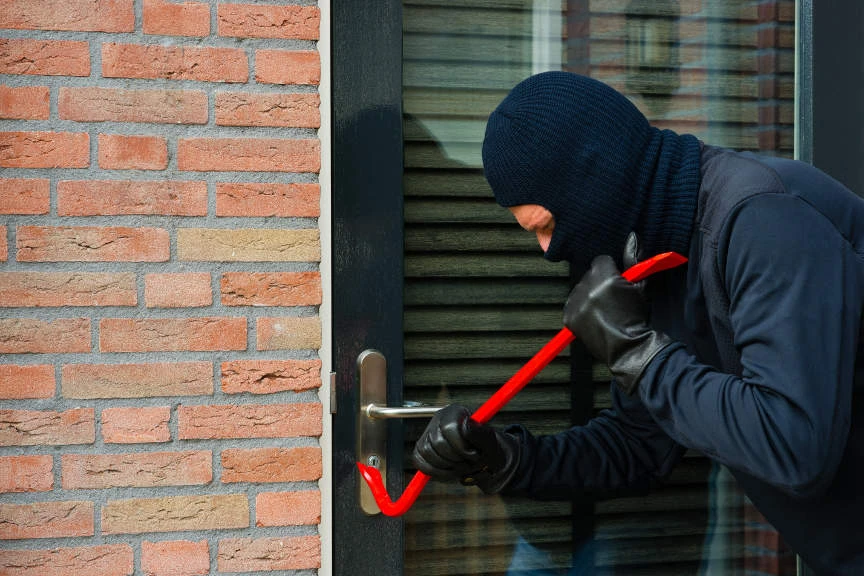Before We Start
[alert type=”warning” close=”false” heading=”Warning”] This article contains statistics, go get some coffee and consider yourself warned. [/alert]Hopefully, that doesn’t scare too many people off. We’re going to be covering some statistics about burglary, and I’ll show you how to determine your probability of being burglarized and your expected monetary losses. We’ll also touch on some more subjective measures of emotional and physical risks associated with burglaries. Wow, even I am starting to fall asleep, so let’s move quickly.
Risk factor – The probability of something happening multiplied by the cost of it happening
How often do home burglaries occur?
Well, it depends. If you’re in the Big Apple, quite a bit. If you’re in Smallville, not so much. Here’s a table for you to figure out where you are (data from the FBI). The table gives the likelihood of a person experiencing a burglary. I’m making an assumption here, Google tells me that each burglary will impact an average household size of 2.55 so I am using that number to scale the burglary rate per 100,000 people to a percentage per household. I suggest you follow along and use the numbers that apply to the place that you live to get in idea of your risk of burglary.
| City Size | Total Burglary Rate Per Household (%) | Forced Entry (%) | Unlawful Entry (%) | Attempted Forced Entry (%) |
|---|---|---|---|---|
| > 1,000,000 | 2.24 | 1.58 | 0.55 | 0.11 |
| 500,00 to 999,999 | 2.74 | 1.9 | 0.65 | 0.19 |
| 250,000 to 499,99 | 2.28 | 1.36 | 0.76 | 0.16 |
| 100,000 to 249,999 | 2.71 | 1.77 | 0.76 | 0.17 |
| 50,000 to 99,999 | 1.82 | 1.04 | 0.66 | 0.13 |
| 25,000 to 49,999 | 1.64 | 0.92 | 0.61 | 0.11 |
| 10,000 to 24,999 | 1.64 | 0.85 | 0.6 | 0.1 |
| < 10,000 | 1.63 | 0.86 | 0.66 | 0.11 |
And here is the likelihood over 10 years that you will have a break-in in these cities:
[skill_bar heading=”Population greater than 1,000,000″ percent=”20%”] [skill_bar heading=”Population 500,000 to 999,999″ percent=”24%”] [skill_bar heading=”Population 250,000 to 499,999″ percent=”21%”] [skill_bar heading=”Population 100,000 to 249,999″ percent=”24%”] [skill_bar heading=”Population 50,000 to 99,999″ percent=”17%”] [skill_bar heading=”Population 25,000 to 49,999″ percent=”15%”] [skill_bar heading=”Population 10,000 to 24,999″ percent=”15%”] [skill_bar heading=”Population less than 10,000″ percent=”15%”]
Tired of reading?
See what your risk is using our calculator.
Determining the Likelihood of a Burglar Breaking into Your Home
Alright, let’s assume the Joe Smokatelli lives in a big city (I’m using 750,000 people) where 2.74% of households experience a burglary during the course of a year. So, the probability that Joe will not have a burglary in the 10 years that he plans to be in his home is (1-.0274)^10 = 76% (remember to divide by 100 to convert the percentage to a 0-1 scale). So, he has roughly a 3 in 4 chance of avoiding a crime. Now, if I am Joe, that is almost a C, and I’m not going to sleep very well at night knowing that.
The Cost of a Break-in
Given that the FBI says the average loss from a burglary is $2230, Joe’s risk factor is 2.74% x $2230 = $61. OK, that doesn’t seem so bad. But, there is still a 2.7% his home will be burglarized each year, and he will lose $2230 when that happens. And, that isn’t considering the emotional impacts of a burglary. The risk factor just provides a quick assessment of his risk.
If you’re following along, you will want to estimate the cost of a burglary for you. Just add up the value of all of the items that are not secured in a safe that can’t be removed. Then, use that number in your risk factor calculation.
- Cash
- Jewelry and precious metals
- Electronics
- Expensive clothing
- Guns
- Cars*
The asterisk after cars indicates that you have to treat this differently. Because of the difficulty of getting rid of a stolen car, 56% of cars are recovered after they are stolen. If you want to include the car in your calculation of the cost of a burglary, it is important that you account for the likelihood of recovering your car. My suggestion is that you discount the value of the car by 30%, because it may be wrecked or stripped of valuables once you get it back. For example, if you have a $10,000 car and assume a 56% chance of recovering it, you would recover a $10,000 x 0.56 * 0.7 = $3920 car. This rolls the probability of recovery as well as the value into a risk factor.
Note: We could also consider the probability that Joe’s stolen items will be recovered (here are some tips if you’re in that situation) into the risk factor calculation. But, since that hovers right around 5% for most items that will likely be taken, we are going to ignore that for now. The assumption is that anything recovered is just bonus.
Other Costs
For me, the thought of my family being home or coming home during a burglary worries me more than the thought of losing valuables. It’s nearly impossible to place a dollar value on your state of mind after being burglarized or assign a cost to your family getting hurt, that is something that judges struggle with in civil suits every day. But, you can still assess your risk tolerance in light of these probabilities. Even though the likelihood of a burglary and an aggravated assault or rape happening during the same break-in is very small, the costs can be very high.
Reducing Your Exposure
Now, what are we going to do about that 76% number.
Well, the FBI information also tells of that 1/4 of the burglaries are considered “unlawful entry.” All that means is that the criminal entered the house without force, likely through an unlocked door or window. So, if we back out those burglaries because Joe always locks his doors when he leaves his house or does some work in the back yard, his new likelihood of avoiding burglary over the course of 10 years becomes (1-0.0274*0.75)^10 or 81%.
Thankfully, other survey data in a study by UNC-Charlotte says that thieves are 3x more likely to break into a house without an alarm system. So if thieves see Joe’s alarm system, then his chance of a burglary goes down to 0.69% per year. His likelihood of having a burglary-free 10 years is now 95%, and he’s moved to the head of the class.
[skill_bar heading=”Chance of Burglary in 10 years WITHOUT a home security system” percent=”24%”] [skill_bar heading=”Chance of Burglary in 10 years JUST locking Joe’s doors” percent=”19%” style=”background-color: #ffc400″] [skill_bar heading=”Chance of Burglary in 10 years WITH JUST a home security system” percent=”7%” style=”background-color: #ffc400″] [skill_bar heading=”Chance of Burglary in 10 years WITH locked doors and a home security system” percent=”5%” style=”background-color: #5fb341″]Risk calculator
Want to see your number? Try our burglary risk calculator.
Naturally, you can also reduce your burglary risk by making it look like someone’s home. Smart lights like Beon can randomly turn your lights on and off while you’re gone to make it look like someone is moving around in the house at night. How cool is that?
Of course, these numbers will vary based on your location and particular situation. Hopefully, what you take from this is that there are practical steps that you can take to protect yourself, your home, and reduce your risk. Maybe Joe could have just bought a security sign for his front yard and gotten most of the benefit of a home security system just by having that as a deterrent.
If you haven’t already, review our DIY home security tips article for ways to make your home more secure without buying a full home security system. Or, if you’re ready to take that next step, head over to our security system review tool to compare systems. Also, share this article with your friends using the buttons below and let them know how much you’re going to reduce your risk of burglary by following our home security tips.
Share this Post

Hi, I’m Jody. I graduated with honors with a Masters of Science in Computer Engineering and have over 15 years of experience working as an engineer with electronics products. I’m a lifelong learner and tinkerer and enjoy automating things around the house so I can solve bigger problems than getting out of bed to check if the garage door is closed . . . like too little sleep!
